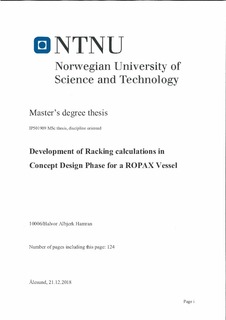| dc.description.abstract | Two racking strength calculations methods have been used to calculate the bending stresses which occurs on a car carrier when a ship is rolling in waves. The accelerations on the ship's structure and deck load will create a force tending to distort the structure transversally and may cause deformation at the comers. To investigate the deformation which occurs at the comers, the given methods from DNV GL, a beam analysis in 3D Beam and a full global FE model in Sesam GeniE is used.
It was found that the beam analysis gives a conservative result, with stresses over the permissible values for bending stress. As the beam analysis is very simplified, structural members contributing to the racking strength is not contributing. The beam analysis can be considered conservative due to the calculations with effective breadths of plates, which reduces the section modulus. Another reason for the conservative results from the beam analysis may be that the method is not intended for ship sizes such as the ship studied in this case. As the stress results from the beam analysis is above the acceptance criteria, the dimensions must be bigger to cope with the large bending moment. Meaning that using the simple method for deciding the cross section, the ship's light weight will be much higher than when using the advanced method.
The results for the full global model showed that the yield criteria for racking ULS was fulfilled, and the structural design could be further improved. As the global FE model is the only calculation method that have approved results, it is the method which should be applied for defining the cross section and calculate the light weight. The amount of work required to apply the global FE model is a disadvantage, but it may still be the most cost efficient solution considering steel weight savings and ship performance. | nb_NO |
